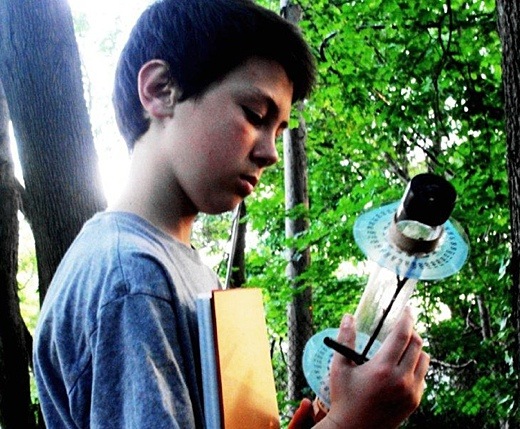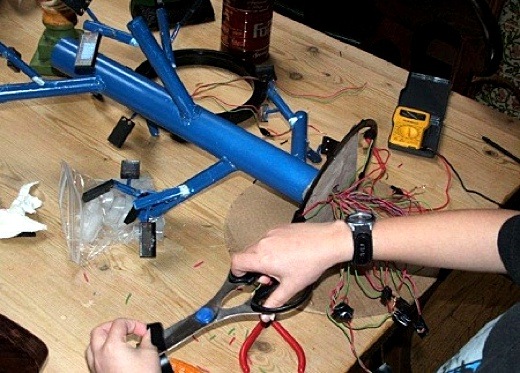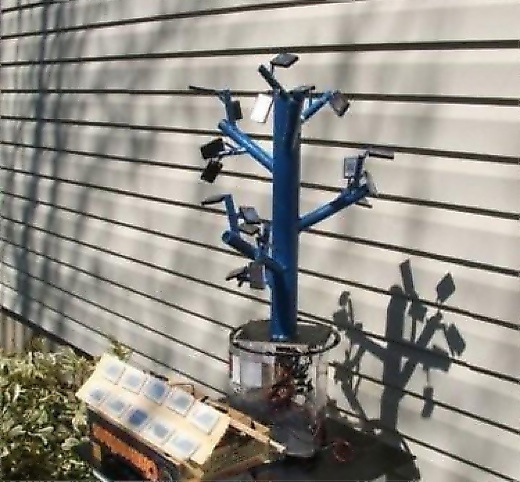[Editor's note: 'Young Naturalist' granted A patent In solar energy. AMNH source article has numerous photos and illustrations by Aiden.]
As told by Aiden Dwyer on 15 August 2011 for American Museum of Natural History - (http://www.amnh.org/nationalcenter/youngnaturalistawards/2011/aidan.html)

Image above: Aiden measure rotational proportion of tree branching with home made device. All images from original article.
I am the Lorax. I speak for the trees. I speak for the trees for they have no tongues." —Dr. Seuss (The Lorax)
People see winter as a cold and gloomy time in nature. The days are short. Snow blankets the ground. Lakes and ponds freeze, and animals scurry to burrows to wait for spring. The rainbow of red, yellow and orange autumn leaves has been blown away by the wind turning trees into black skeletons that stretch bony fingers of branches into the sky. It seems like nature has disappeared.
But when I went on a winter hiking trip in the Catskill Mountains in New York, I noticed something strange about the shape of the tree branches. I thought trees were a mess of tangled branches, but I saw a pattern in the way the tree branches grew. I took photos of the branches on different types of trees, and the pattern became clearer.

Image above: Building test solar energy collector using oak tree ratios of branch placement.
The branches seemed to have a spiral pattern that reached up into the sky. I had a hunch that the trees had a secret to tell about this shape. Investigating this secret led me on an expedition from the Catskill Mountains to the ancient Sanskrit poetry of India; from the 13th-century streets of Pisa, Italy, and a mysterious mathematical formula called the "divine number" to an 18th-century naturalist who saw this mathematical formula in nature; and, finally, to experimenting with the trees in my own backyard.
My investigation asked the question of whether there is a secret formula in tree design and whether the purpose of the spiral pattern is to collect sunlight better. After doing research, I put together test tools, experiments and design models to investigate how trees collect sunlight. At the end of my research project, I put the pieces of this natural puzzle together, and I discovered the answer. But the best part was that I discovered a new way to increase the efficiency of solar panels at collecting sunlight!
My investigation started with trying to understand the spiral pattern. I found the answer with a medieval mathematician and an 18th-century naturalist. In 1209 in Pisa, Leonardo of Pisano, also known as "Fibonacci," used his skills to answer a math puzzle about how fast rabbits could reproduce in pairs over a period of time. While counting his newborn rabbits, Fibonacci came up with a numerical sequence. Fibonacci used patterns in ancient Sanskrit poetry from India to make a sequence of numbers starting with zero (0) and one (1).
Fibonacci added the last two numbers in the series together, and the sum became the next number in the sequence. The number sequence started to look like this: 1, 1, 2, 3, 5, 8, 13, 21, 34... . The number pattern had the formula Fn = Fn-1 + Fn-2 and became the Fibonacci sequence. But it seemed to have mystical powers! When the numbers in the sequence were put in ratios, the value of the ratio was the same as another number, φ, or "phi," which has a value of 1.618. The number "phi" is nicknamed the "divine number" (Posamentier).
Scientists and naturalists have discovered the Fibonacci sequence appearing in many forms in nature, such as the shape of nautilus shells, the seeds of sunflowers, falcon flight patterns and galaxies flying through space. What's more mysterious is that the "divine" number equals your height divided by the height of your torso, and even weirder, the ratio of female bees to male bees in a typical hive! (Livio)

Image above: Aiden tests solar "tree" versus conventional solar panel grid for efficiency.
I set the two models in the same location in my backyard facing the southern sky and measured their output over a couple of months. I moved the test location around to vary the conditions.
The sunlight conditions were also important. I started my measurements in October and tested my models through December. At that time of year the winter solstice was coming, and the Sun was moving into a lower declination in the sky. The amount of sunshine was shortening. So I was testing the Fibonacci pattern under the most difficult circumstances for collecting sunlight.
I compared my results on graphs, and they were interesting! The Fibonacci tree design performed better than the flat-panel model. The tree design made 20% more electricity and collected 2 1/2 more hours of sunlight during the day. But the most interesting results were in December, when the Sun was at its lowest point in the sky. The tree design made 50% more electricity, and the collection time of sunlight was up to 50% longer!
I had my first evidence that the Fibonacci pattern helped to collect more sunlight. But now I had to go back and figure out why it worked better. I also began to think that I might have found a new way to use nature to make solar panels work better.
I learned that making power from the Sun is not easy. The photovoltaic ("PV") array is the way to do it. A photovoltaic array is a linked collection of multiple solar cells. Making electricity requires as much sunlight as possible. At high noon on a cloudless day at the equator, the power of the Sun is about 1 kilowatt per square meter at the Earth's surface (Komp).
Sounds easy to catch some rays, right? But the Sun doesn't stand still. It moves through the sky, and the angle of its rays in regions outside the equator change with the seasons. This makes collecting sunlight tricky for PV arrays. Some PV arrays use tracking systems to keep the panels pointing at the Sun, but these are expensive and need maintenance. So most PV arrays use fixed mounts that face south (or north if you are below the equator).
Fixed mounts have other problems. When a PV array is shaded by another object, like a tree or a house, the solar panels get backed up with electrons like cars in a traffic jam, and the current drops. Dirt, rain, snow and changes in temperature can also hurt electricity production by as much as half! (Komp)
I began to see how nature beat this problem. Collecting sunlight is key to the survival of a tree. Leaves are the solar panels of trees, collecting sunlight for photosynthesis. Collecting the most sunlight is the difference between life and death. Trees in a forest are competing with other trees and plants for sunlight, and even each branch and leaf on a tree are competing with each other for sunlight. Evolution chose the Fibonacci pattern to help trees track the Sun moving in the sky and to collect the most sunlight even in the thickest forest.
I saw patterns that showed that the tree design avoided the problem of shade from other objects. Electricity dropped in the flat-panel array when shade fell on it. But the tree design kept making electricity under the same conditions. The Fibonacci pattern allowed some solar panels to collect sunlight even if others were in shade. Plus I observed that the Fibonacci pattern helped the branches and leaves on a tree to avoid shading each other.
My conclusions suggest that the Fibonacci pattern in trees makes an evolutionary difference. This is probably why the Fibonacci pattern is found in deciduous trees living in higher latitudes. The Fibonacci pattern gives plants like the oak tree a competitive edge while collecting sunlight when the Sun moves through the sky.
My investigation has created more questions to answer. Why are there different Fibonacci patterns among trees? Is one pattern more efficient than another? More testing of other types of trees is needed. I am testing different Fibonacci patterns now. I am improving my tree design model to see if it could be a new way of making panel arrays. My most recent tries with a bigger test model were successful.
The tree design takes up less room than flat-panel arrays and works in spots that don't have a full southern view. It collects more sunlight in winter. Shade and bad weather like snow don't hurt it because the panels are not flat. It even looks nicer because it looks like a tree. A design like this may work better in urban areas where space and direct sunlight can be hard to find.
But the best part of what I learned was that even in the darkest days of winter, nature is still trying to tell us its secrets!
No comments :
Post a Comment